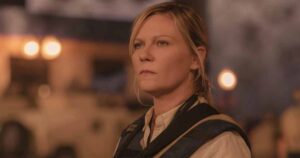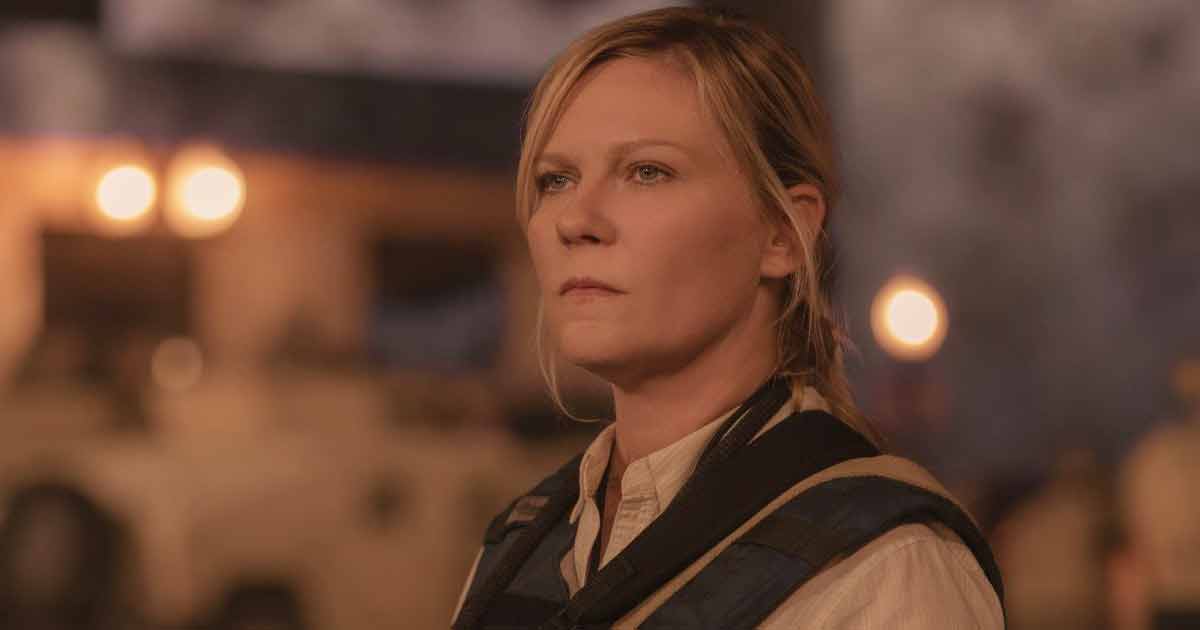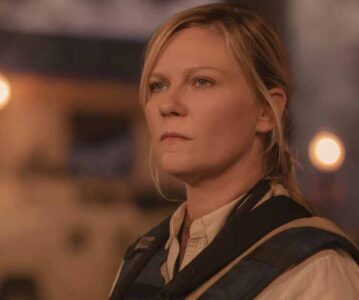Leland Olds reviews director Alex Garland’s recent war-action film “Civil War,” arguing that the film’s representation of violence speaks to the anxieties of liberals and journalists at the expense of exploring the real costs of war.

For a while in the early 2010s, there was a subreddit called r/watchpeopledie. It was a strange place dominated by entrancing, almost narcotic clips from the first wave of digital combat videos: the wavering line of a tank shell flying towards a camera lens, the whip-crack of machine gun rounds over an open-topped armored personnel carrier, or the silent fall of a hand grenade from a quadcopter onto a prepared fighting position. Following a series of personal disasters, I ended up on that forum night after night, too drunk to speak, watching the same videos over and over again, while I waited to feel something.
At the time—before the development of a whole brigade of teenaged and near-retirement westerners who take pornographic joy in footage of conscripted 20 year olds getting vaporized by howitzer shells in the Donbas—these videos were the refuge of the truly sadistic and the merely depressed. I identified myself symbolically with those victims of a violence which was both final and, from my perspective, repeatable. It was a way to externalize, interpret, and work over the interpersonal violence I experienced and witnessed in my late teens. Even then I understood there was something shameful or perverse in using other people’s real deaths to remind myself that I was alive. But that’s the thing about violence, you come back to it, again and again, in secret, in dreams, in the long, gray hours at the end of a bender, hoping that this time it’s different.
Alex Garland’s recent film, Civil War, serves the same purpose for the perpetrators and beneficiaries of imperial violence, rather than its victims. The film appropriates the accumulated images of US war crimes and repurposes them as a pathway for US liberalism to discharge its anxiety about the political present.
The movie follows a group of four journalists, three professional and one amateur, during a future civil war in the United States. Most of the plot covers the group’s journey from New York City to Washington, D.C., where NYT reporter Sammy (Stephen McKinley Henderson) tells the others “they shoot journalists on sight.” The film hews close to the perspectives of Less Smith (Kirsten Dunst) and Jessie Cullen (Cailey Spaeny). The former is an experienced war photographer, the latter an ambiguously aged (Wagner Moura’s character, Joel, describes her as “like 23”) amateur film photographer who wants to be a professional.
Much of the first and second act is given to Smith’s attempts to reject Cullen and the latter’s shock at experiencing combat for the first time. In one sequence, Cullen discovers two detainees being tortured by militia. Smith persuades the torturer to allow himself to be photographed. Cullen, shaken by the experience, fails to get the shot. Following this, the tension and stakes of the action sequences escalate, until Sammy is mortally wounded. Two journalists from Hong Kong are killed in an encounter with unaffiliated racist militants led by Jess Plemmons, whose character has no name and is uncredited.
Cullen gradually gains confidence as a photographer, while Smith’s ability to maintain emotional detachment erodes. These arcs end with Cullen standing directly in the line of fire in the film’s final sequence, trying to get a picture of secret service agents defending the President (Nick Offerman). Smith tackles Cullen and gets shot by the secret service in a classic mentor-saves-protege bit. Cullen and Joel go on with the rebel forces to find the president in the Oval Office, where he is summarily executed.
Much of the violent imagery of the US empire is reproduced in this movie: the mass graves gashed into the soil and the bodies dusted in quicklime, summary executions of political opponents and racialized noncombatants, the torture of detainees, the clash between riot cops and popular demonstrations, suicide bombings, sniper fire, and close urban combat. Even vehicular manslaughter gets its moment.
Notably absent are—as in All Quiet—artillery and aerial bombardment. Those are still the war-winning weapons systems of the 21st century, as the defeat of the Armenians in 2020, the repulse of the TDF/TPLF on the road to Addis, and the grinding attrition of the Russo-Ukraine war show. Still, these forms of war are uniquely uncinematic, as I discussed in my essay on All Quiet (under a previous pseudonym). They produce primarily terror and boredom. The images that follow bombardment are ones of immense suffering and devastation, rather than the dynamism needed for a road trip movie.
Also missing is the corpse desecration and torture of wounded captives so beloved of the United States and its allies, though I must confess I was relieved we did not have to watch Nick Offerman get sodomized by a bayonet like Qaddafi, whose death is mentioned early in the first act.
Still the reproduction of so many of the crimes of empire as spectacle reads as a way to process US participation in mass political violence. The lack of clear political content and the emphasis on the aesthetics of violence show Civil War is a libidinal sink for US liberalism. All the aggression and energies expended abroad can be safely reproduced, recontextualized, condemned, and then forgotten through the process of filmic catharsis.
This project is aided by the film’s culmination. In a moment somewhat reminiscent of the Casado coup in Spain in 1939, disaffected generals usurp political authority from the legitimate government and negotiate a surrender with the rebels. The rebels, a coalition of ‘Western Forces’ (Liberal Federalists, so far as ideology can be discerned) and ‘The Florida Alliance,’ (whatever) storm into the capital, wipe out the remnants of the president’s bodyguard and bust into the White House with the journalists participating.
The murder of the president destroys the source of organized violence and of disorganized violence. It is, on the one hand, the annihilation of the ultimate father figure and, on the other, the cleansing of the father figure by expelling the corrupt element. I think it’s simplistic to read this as a suggestion that murdering Donald Trump after he wins 325 electoral votes this fall will clean up US politics. Rather, the moment makes it possible to treat the violence of US empire as fictional, to allow the audience to say: well if it were that bad, surely we’d have killed him by now. This is an inversion of post-nut clarity where the penetrative act (shooting the president in the fucking head) closes the psychic wound and makes it possible to repress the knowledge of violence. We have here not the dissolution of the political self through a culmination point, but a reconstruction of the political self through the same process. Masturbation, in lieu of sex, if you will allow me a moment of pop psychoanalysis.
And, who doesn’t love jerking off?
Men Do, Women See.
Garland’s movie doesn’t really have characters, so much as stereotypes of different reporters: drunk writer, good writer, numb photographer, overly-sensitive cub.
Incidentally, the agency of characters breaks down easily along gendered lines. Women receive action. Men perpetrate it (the lone exception to this is the murder of the president, though this is precipitated by Joel asking the soldiers not to shoot until he’s got a quote).
Photography is the freezing of perception. As such, it is the ultimate passive act. The photographer merely sees, but is unable to comment even, on the events before them. In a few scenes, we get still photographs of the action, pictures generally of men broken open, men shooting, men helping wounded men. The dark void of the camera lens captures the light, external, masculine presence, usually at the moment of its symbolic violation or its symbolic triumph. The women photographers freeze the world for a moment inside their cameras. They are non-participants in the violence of war until Smith shoves Cullen out of the way and is punished for her action with death.
The women in this movie exist to see, not to do.
This stands in direct contrast to the men. I’ve already mentioned Joel’s intervention to delay the murder of the president. The more glaring example is when Sammy, the Times reporter, runs over Jesse Plemons with a big ass SUV. Throughout the preceding scene, Plemons has interrogated the group of reporters. Cullen is barely capable of answering him, but Joel tries to intervene to persuade Plemons that they’re Americans. Joel talks. He projects the self into the outside world, Sammy acts directly on the external world. Their professions differ too. The written word, more than the photograph, is a generated object. Words must be selected, arranged, or spoken, while images are merely taken. Written journalism depends on the interpretation and reproduction of reality in another form. Photojournalism, at its semiotic core, should come as close as possible to preserving the image of the moment.
We get another glimpse of the film’s bizarre, anti-feminist gender politics when the crew stop in an Appalachian town guarded by rooftop militiamen (the repressed memory of urban insurrection making its appearance). Smith and Cullen step into a thrift store. The following scene presents two moments of absurd gender politics. First, the insistence by the shop’s proprietor that she doesn’t even really think about the war. Second, Smith is persuaded by Cullen to try on a dress.
It’s not a subtle moment, just a saccharine recreation of gendered domesticity to soften a character who stands out primarily for her alleged competence and pragmatism. As if their reduction to image receptacle were not humiliating enough, these characters must be made to dress up like dolls.
It’s pretty fucking stupid.
They Shoot Journalists on Sight in the Capitol
One of the common responses to Civil War was bemusement at the political alignments. This, I think, is an example of the US audience’s reflexive inability to imagine even the slightest difference from the prevailing order.
I don’t really think there’s anything particularly fantastical about the alignment of Texas and California. Both are large regions dominated by unholy alliances of tech, agrarian, and extractive capital, with fairly similar class compositions. They are geographically and economically coherent enough to form the basis of a polity independent of the central authority of Washington, each with its own deep water ports, urban centers, agrarian hinterlands and, to some extent, natural frontiers (the Sierra Nevadas, and the Red and Sabine Rivers). The political differences between the two states, while profound on the cultural level, would be of less structural significance at a moment when a weakened central power tries to reassert control.
Federalists, in the broad sense rather than the US partisan sense, often lose civil wars because the social forces they represent lack the coherence or hegemonic potential of a centralizing ruling class. But the decline of such a class—exacerbated by a crisis of legitimacy at the level of formal politics—could make temporary regional alignments politically attractive in the immediate term.
In reality, the structural factor which has prevented the US’ political polarization from developing into a civil war is the continued consolidation of the trans-national capitalist class and the decline of competing, regionally based power centers. So long as regional bourgeoisies continue to fade or find themselves subordinated to the economic power of an international capitalist class, the social basis for a civil war—along the lines imagined by this movie—will not develop in the United States.
There are other nitpicky realism problems. None of the journalists have the requisite equipment to cover a high school basketball game, let alone the closing stages of a war.
Civil War and the US Journalist Class
Before I close here, I want to talk about journalists. US journalists love to pretend they’re heroes and that they are being persecuted. It’s hard to think of a more self-interested and less perspicacious professional stratum anywhere in the world. This movie reproduces their de-politicized libidinal concerns perfectly.
US Journalists, meaning specifically the well-paid corporate hacks, love to believe they’re being persecuted. Every time a political figure in the US criticizes reporters, the press responds as if such comments could precipitate the general massacre of the profession. Some journalists in the United States are persecuted—Assange, for instance, or the investigative reporters looking at factory farms, whose reporting has led agricultural capital to successfully ban whole categories of journalism—but the bulk of the profession are not engaged in those types of reporting.
Reporters who run approved “leaks” from anonymous state department sources whose jobs are never in danger like to think they’re Woodward and Bernstein, and that their constant regurgitation of pop-psychology, industry talking points, and law enforcement rumor passes for investigation. Deep down, they crave the moral legitimacy that comes with facing danger.
The journalists in Civil War aren’t really reporting. They don’t file stories. They don’t even carry notebooks. In the end, they risk their lives for a soundbite from a powerful man, which is what US journalists think they do on the daily.
The moral trouble with this type of fantasy is that there is a place where journalists are shot on sight. In Gaza, the Israeli military has murdered over 100 journalists.
About two weeks after Civil War was released, a thousand or so demonstrators gathered along Connecticut Ave to heckle and harangue the attendees of the White House Correspondents dinner. It was one of the last cold days in Washington, drizzling and damp, with a low wind blowing, a little raw, a little messy. You could get away with wearing layers.
The organizers laid bloody press vests on the sidewalk in a memorial for the murdered reporters of Palestine. While the crowd behind me shouted at state department hacks and smarmy media types, I stood transfixed before our martyred dead. The murdered journalists of Gaza were not war correspondents. Many of them weren’t even reporters. They were producers, digital editors, audience engagement leads, site engineers, cameramen, sports writers, and managing editors, alongside the Shireen Abu Aklehs of the world, whose faces and bylines audiences know. This is the top-to-bottom destruction of a profession, not the targeted killing of a handful of outspoken muckrakers. If the Israelis have their way, the entire craft of journalism shall be wiped from Palestine and the silence of the rest of the press will eat away, like gangrene, at the ability and integrity of reporters everywhere.
In my day job, I work in a very boring part of the media-industrial complex. These martyred dead were my colleagues. They were my brothers and sisters, though language and geography separated us, though I never met them face-to-face. They were murdered, they are still being murdered, by the US empire, abetted by the people for whom Civil War functions as a libidinal liability sink.
Behind me, the TV reporters and the newspaper publishers laughed from the safety of the SS defensive barricades.
I broke down and wept before this sight of unaccepted suffering, this base betrayal of craft solidarity. Whatever happens to US journalists in the next generation, we have earned with our silence on Gaza and our loud insistence that we are not guilty.
Because we have allowed Washington to shoot journalists on sight in Gaza. One day, we will be shot here.





